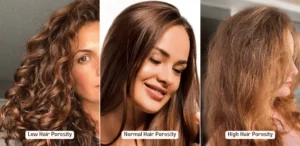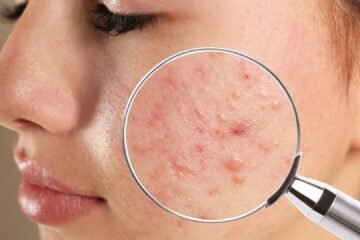Hey there! Are you excited to embark on a hair care adventure with us? Get ready to immerse yourself in a world of creativity, innovation, and self-expression through your hair. Our blog is your go-to destination for a treasure trove of hair wisdom, from intricate styling techniques to eco-friendly product reviews. Join us as we unravel the secrets to healthy, beautiful hair and discover the latest trends shaping the world of hair care. Let’s journey together towards hair empowerment and self-confidence!
In this blog, we will tell you about what is hair porosity and what is your hair porosity.

WHAT IS HAIR POROSITY AND HOW TO KNOW YOUR HAIR POROSITY:

Hair porosity is a crucial factor in understanding how your hair absorbs and retains moisture, which can impact its overall health, hair care and appearance. Hair porosity is categorized into three main types: low porosity, normal porosity, and high porosity.
Low porosity hair has a tightly bound cuticle layer, making it difficult for moisture to penetrate. This type of hair often appears shiny and feels smooth but can be prone to product buildup.
Normal porosity hair has a balanced cuticle layer that allows moisture to enter and retain it effectively. This type of hair is considered the healthiest and easiest to maintain.
High porosity hair has gaps and holes in the cuticle layer, causing moisture to enter quickly but also escape just as fast. High porosity hair tends to be dry, frizzy, and prone to damage.
To test your hair porosity, you can try the float test. Here’s how you can do it:
1. Take a few strands of clean hair (preferably from your brush).
2. Fill a glass of water.
3. Drop the hair strands into the water.
4. Observe how the hair behaves:
– If the hair floats on the surface, it indicates low porosity.
– If the hair sinks slowly, it indicates normal porosity.
– If the hair sinks quickly, it indicates high porosity.
Understanding your hair porosity can help you tailor your hair care routine by selecting the right products and treatments that suit your hair’s specific needs.
HAIR CARE FOR HIGH POROSITY HAIR:

To take care of high porosity hair, it’s essential to focus on moisture retention and protection to prevent further damage. Here are some tips to help you care for your high porosity hair:
- Deep Conditioning: Use deep conditioning treatments regularly to help hydrate and nourish your hair. Look for products with ingredients like shea butter, coconut oil, or argan oil to help seal moisture into your hair.
- Leave-In Conditioner: Apply a leave-in conditioner after washing your hair to provide extra moisture and protection. This will help keep your hair hydrated throughout the day.
- Seal in Moisture: Use oils such as jojoba oil, argan oil, or avocado oil to seal moisture into your hair. Apply a small amount of oil to the ends of your hair to help prevent moisture loss.
- Avoid Heat Styling: Limit the use of heat styling tools like flat irons and curling irons, as high porosity hair is more prone to heat damage. If you must use heat, make sure to use a heat protectant spray.
- Protective Styling: Opt for protective hairstyles like braids, buns, or twists to minimize exposure to environmental factors that can further damage your hair.
- Regular Trims: Trim your hair regularly to get rid of split ends and prevent further damage from traveling up the hair shaft.
- Avoid Harsh Chemicals: Limit the use of chemical treatments like bleaching or coloring, as these can further weaken high porosity hair.
By following these tips and adopting a gentle hair care routine, you can help manage and improve the condition of your high porosity hair.
HAIR CARE FOR NORMAL POROSITY HAIR:

For normal porosity hair, the goal is to maintain a balance of moisture and protein to keep your hair healthy. Here are some tips to help you take care of normal porosity hair:
- Balanced Products: Use a balanced combination of moisturizing and protein-rich products to keep your hair healthy. Look for products that are specifically formulated for normal porosity hair.
- Deep Conditioning: Regular deep conditioning treatments can help maintain the moisture-protein balance in your hair. Consider using a deep conditioner once a week to keep your hair hydrated and strong.
- Avoid Overloading: Be mindful of not overloading your hair with too many products. Use a moderate amount of product to prevent buildup and maintain the natural balance of your hair.
- Regular Trims: Keep your hair healthy by getting regular trims to remove split ends and prevent damage from traveling up the hair shaft.
- Protective Styling: Consider protective styles like braids or buns to minimize exposure to environmental factors that can damage your hair.
- Heat Styling: If you use heat styling tools, make sure to use a heat protectant spray to prevent heat damage and maintain the health of your hair.
- Healthy Diet: Remember that the health of your hair is also influenced by your diet. Eating a balanced diet rich in vitamins and minerals can support the health of your hair.
By following these tips and customizing your hair care routine to suit the needs of your normal porosity hair, you can maintain its health and vitality.
HAIR CARE FOR LOW POROSITY HAIR:

To care for low porosity hair, it’s important to focus on products and techniques that help open up the cuticle layer to allow moisture to penetrate effectively. Here are some tips to help you care for your low porosity hair:
- Use Heat: Heat can help open up the cuticle layer of low porosity hair, making it easier for products to be absorbed. Try using a hooded dryer or a warm towel when deep conditioning to help the products penetrate your hair shaft.
- Clarifying Shampoo: Use a clarifying shampoo occasionally to remove product buildup that can prevent moisture from entering your hair. This will help your hair absorb moisture better.
- Lightweight Products: Opt for lightweight, water-based products that won’t weigh down your hair. Look for leave-in conditioners and styling products that are easily absorbed.
- Avoid Heavy Oils: Heavy oils like coconut oil or castor oil can sit on the surface of low porosity hair and make it greasy. Instead, try lighter oils like argan oil or grapeseed oil.
- Avoid Overusing Protein: While protein treatments can be beneficial for low porosity hair, overusing them can lead to protein buildup, making your hair stiff and brittle. Use protein treatments in moderation.
- Moisturize Regularly: Since low porosity hair struggles to retain moisture, it’s important to moisturize regularly. Use water-based moisturizers and seal in the moisture with a light oil.
- Avoid High Humidity: Low porosity hair can be prone to frizz in high humidity. Use anti-humidity products or protective styles to prevent frizz and retain moisture.
By following these tips and incorporating them into your hair care routine, you can help manage and improve the health of your low porosity hair.
By incorporating a balanced combination of moisturizing and protein-rich products, regular deep conditioning treatments, avoiding product overload, getting regular trims, trying protective styling, using heat protectant when styling, and maintaining a healthy diet, you can effectively care for your normal porosity hair. These steps will help you keep your hair healthy, strong, and looking its best.
By using this site, you agree to the Terms and conditions and Privacy Policy of https://beautyvitalityco.com/
Previous post: https://beautyvitalityco.com/10-natural-skincare-products/



1 Comment
5 Steps Daily Hair Care Routine: A Guide To Healthy Hair - Beauty Vitality Co · July 18, 2024 at 6:10 pm
[…] Previous post: https://beautyvitalityco.com/15-hair-care-secrets/ […]